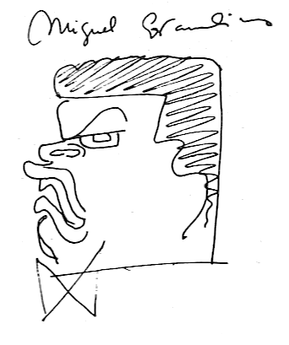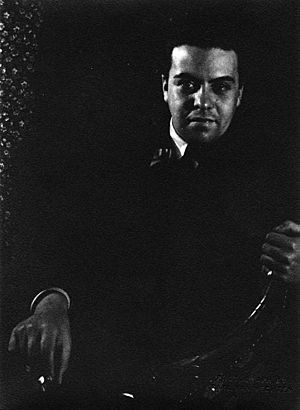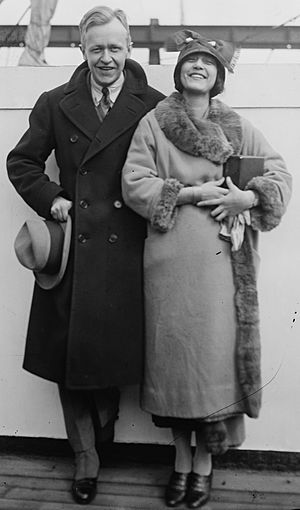Miguel Covarrubias facts for kids

Miguel Covarrubias, also known as José Miguel Covarrubias Duclaud (born November 22, 1904 – died February 4, 1957), was a talented Mexican artist. He was a painter, a caricaturist (someone who draws funny pictures of people), and an illustrator (someone who draws pictures for books). He also studied different cultures as an ethnologist and knew a lot about art history.
Miguel Covarrubias helped discover the ancient Olmec civilization with his American friend Matthew W. Stirling.
Contents
Early Life and Art Beginnings
José Miguel Covarrubias Duclaud was born in Mexico City on November 22, 1904. He finished school at the National Preparatory School when he was only 14 years old.
After school, he started drawing funny pictures and illustrations for books and learning materials. These were published by the Mexican Ministry of Public Education. He also worked for the Ministry of Communications.
Moving to New York City
In 1923, when Miguel was 19, he moved to New York City. He had a special scholarship from the Mexican government. He was very talented, but he knew very little English.
In a book about him, author Adriana Williams says that Mexican poet José Juan Tablada and New York Times writer Carl Van Vechten helped him meet important artists and writers in New York. Soon, Miguel was drawing for popular magazines. He became one of the best caricaturists for Vanity Fair magazine.
Theatre and Travel Adventures
Miguel Covarrubias had many talents. He also started designing the backgrounds and costumes for plays. He worked on shows like Caroline Dudley Reagan's La Revue Negre, which starred Josephine Baker. This show made Josephine Baker very famous in Paris.
He also designed for other shows, including Androcles and the Lion and The Four Over Thebes. He worked on the Garrick Gaities' Rancho Mexicano dance number for Rosa Rolando. Rosa was a dancer and choreographer.
Traveling with Rosa Rolando
Miguel and Rosa fell in love. They traveled together to Mexico, Europe, Africa, and the Caribbean in the 1920s. During one trip to Mexico, Rosa and Miguel traveled with photographers Tina Modotti and Edward Weston. Edward taught Rosa how to take pictures.
Rosa also met Miguel's family and friends, including the famous artist Diego Rivera. Rosa became a lifelong friend of Diego Rivera's third wife, the artist Frida Kahlo.
Caricatures and Illustrations
Miguel's artwork and funny drawings of famous people were shown in The New Yorker and Vanity Fair magazines. His drawing style, with its clear lines, influenced other caricaturists like Al Hirschfeld.
Miguel's first book of caricatures, The Prince of Wales and Other Famous Americans, was very popular. However, not everyone he drew was happy about his sharp, clever humor aimed at them!
Harlem Jazz and Culture
Miguel loved the jazz music scene in Harlem, New York. He often went there with Rosa and friends like Eugene O'Neill and Nickolas Muray. He was friends with many famous people, including Zora Neale Hurston, Langston Hughes, and W.C. Handy. He also drew pictures for their books.
Miguel's drawings of jazz clubs were the first of their kind to be printed in Vanity Fair. He captured the spirit of the Harlem Renaissance (a time of great artistic and cultural growth for African Americans) in much of his work. He also did this in his book, Negro Drawings. He saw these as serious drawings of people, music, and a culture he truly admired.
Book Illustrations and Recognition
Covarrubias also drew pictures for George Macy, who published books for The Limited Editions Club. These included Uncle Tom's Cabin, Green Mansions, Herman Melville's Typee, and Pearl Buck's All Men Are Brothers. These books are now highly valued by collectors.
He also worked with Austrian artist Wolfgang Paalen on his journal Dyn from 1942 to 1944. Miguel's advertising, painting, and illustration work made him famous around the world. He had art shows in Europe, Mexico, and the United States. He also won awards, like the 1929 National Art Directors' Medal for his colorful painting in a Steinway & Sons piano advertisement.
Painting Large Murals
Miguel Covarrubias was asked to create a set of murals for the 1939-1940 Golden Gate International Exposition (a big fair) in San Francisco. This fair was held on Treasure Island.
He painted six large murals called Pageant of the Pacific. These murals were the main attraction at the Pacific House, a place where people could learn about the cultures and interests of countries around the Pacific Ocean. Miguel painted these murals with his helper, Antonio M. Ruiz.
The Pacific Murals
The murals were huge, illustrated maps. They showed:
- The Fauna and Flora of the Pacific (animals and plants)
- Peoples
- Art and Culture
- Economy
- Native Dwellings (homes)
- Native Means of Transportation (ways of travel)
These murals were very popular at the fair. Later, they were shown at the American Museum of Natural History in New York. Five of the murals were then put in the World Trade Club in the Ferry Building, where they stayed until 2001. No one knows where the sixth mural, Art and Culture, is today.
The Fauna and Flora of the Pacific mural is now on display at the de Young museum in San Francisco. This colorful map shows the four continents around the Pacific Ocean. It has examples of their plants and animals floating in a swirling Pacific Ocean filled with sea creatures.
Personal Life and Later Work
Miguel and Rosa got married in 1930. They used the money from Miguel's art award to go on a long honeymoon to Bali. There, they learned about the local culture, language, and customs.
Miguel went back to Southeast Asia (Java, Bali, India, Vietnam) in 1933. He had a special scholarship called a Guggenheim Fellowship. Rosa went with him and took photos that were used in Miguel's book, Island of Bali. This book helped make Bali very popular in New York in the 1930s. He also spent time in China, where his work influenced artists in Shanghai.
Rosa and Miguel returned to live in Mexico City. Miguel continued to paint, illustrate, and write. Their home, Tizapán, became a gathering place for visitors from all over the world, including Nickolas Muray, Dolores del Río, and Nelson Rockefeller.
Miguel taught about cultures at the Escuela Nacional de Antropología e Historia (National School of Anthropology and History). He was also put in charge of a new department at the Palacio de Bellas Artes (National Palace of Fine Arts). His job was to add an Academy of Dance. Rosa, with her background in dance, was very helpful with this. Miguel invited his friend, dancer José Limón, to bring his dance company from New York City for the first season in 1950. José Limón taught at Bellas Artes and helped the new Mexican modern dance company become known internationally. During Miguel's time there, traditional Mexican dance was studied and preserved. This research helped start a new era in modern Mexican dance.
Legacy and Influence
Miguel Covarrubias passed away on February 5, 1957, in Mexico City.
His unique art style was very influential in America, especially in the 1920s and 1930s. His artwork and funny drawings of important people were featured on the covers of The New Yorker and Vanity Fair.
Covarrubias is also known for his studies of ancient art from Mesoamerica (the region of Mexico and Central America), especially the Olmec culture. He believed that Mexican culture spread north to other Native American cultures, like the Mississippian people. His studies of ancient symbols showed that the Olmecs existed before the Classic Era, long before archaeologists confirmed it.
He shared his love for different cultures with the world through his drawings, paintings, writings, and caricatures.
See also
 In Spanish: Miguel Covarrubias para niños
In Spanish: Miguel Covarrubias para niños




